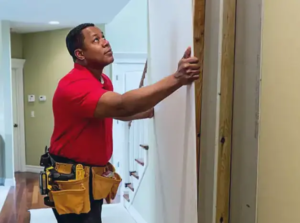Landscaping Fayetteville AR makes your home and property look well cared for and adds to your property value. It can also help lower energy costs by shading your house in summer and blocking unwanted views.

Visit botanical gardens, arboretums and local garden centers for ideas. Take photos and keep notes about what you like.
The shape of plants and other landscape elements is called form. It is one of the five design principles that creates the visual appeal of a landscape. The shapes of beds, paths and walkways must work well together to give a cohesive look to the entire landscape. The shapes of trees, hedges and other vegetation must complement the shape of the house.
The size of objects in a landscape is also important. Larger plants have a greater impact on the landscape than smaller plants. This is why it is important to keep the scale of plants in balance with the overall size of the landscape.
When different elements of the landscape are repeated at regular intervals it creates rhythm. The rhythm of a landscape helps to establish a mood and can influence the way people view it. The repetition of elements could be the lines of a garden bed, tree rings, lamp posts or even the edging of turf areas.
Line is an essential design principle for a balanced landscape because it determines the physical flow of the space. It can be straight, curved, horizontal or vertical. Straight lines can yield a more formal appearance, while curved lines add a more natural feel. Horizontal lines can expand small spaces, and vertical lines help to pull the eye upward.
Landscape forms evoke emotion and can set the tone for the entire landscape. Rectilinear forms are structured and formal, circles are soft, triangles are strong, and irregular shapes are casual and free.
Texture is a crucial element in the landscape because it provides a touch of visual interest to the design. The coarseness or fineness of a leaf, the roughness or smoothness of bark and the heaviness or lightness of foliage all contribute to the texture of a landscape. Contrasting textures are also important because they add contrast and bring attention to certain landscape features.
Unity is the final aspect of a landscape design and refers to how the various parts of the landscape fit together as a whole. To create a sense of unity the other design principles such as color, line, form and texture should all be used consistently. Unity is easily achieved if the other design principles are used to guide the selection of plants and hardscapes.
Texture
The visual textures of a garden create a sense of depth and interest. They play a vital role in the overall landscape design and are one of the most important factors in a garden’s beauty. Texture describes how coarse or fine, smooth or rough, light or heavy all the elements of a planting feel and look individually and together. It encompasses the fineness or coarseness of a plant’s foliage, flowers, stems, and bark as well as its overall branching pattern and size. The texture of a plant can change dramatically with the amount of light and the distance from which it is viewed.
In general, coarse-textured plants carry the most weight in a landscape while fine-textured plants add to the balance. However, a combination of both coarse and fine textures can produce eye-catching, visually compelling combinations. In addition, using a mixture of textures helps prevent monotony.
Plant textures can also be heightened or diminished by color. Bold colors increase contrast and make a coarse texture appear even more coarse, while muted colors tend to flatten a texture. Combining a variety of plant textures with varying forms can produce interesting and dynamic combinations that are aesthetically pleasing to the eye. For example, pairing the large-leafed, structural agave with the delicate feather grasses and ferns can provide both a dramatic and harmonious blend.
The use of contrasting plant textures can also help define a garden’s space and create a sense of scale in the planting. It is important to note, however, that the choice of plants for a specific space must also take into account their maintenance requirements. Many plants with certain textures require a lot of pruning and may be more prone to insect damage or disease than other plants.
While color is often given the most attention in a garden, it’s critical to pay close attention to texture when designing your landscape. Making intentional choices relative to this attribute will ensure that your landscape is visually stimulating, enduring and enjoyable throughout the seasons. It will also provide a living canvas that reflects your personality and complements your home’s architectural style.
Space
Landscaping involves the design and implementation of outdoor spaces. It aims to create visually appealing designs that reflect the client’s personality and lifestyle while harmonizing with the existing environment. A well-crafted landscaping project can increase the value of a home or commercial building, improve health and wellness, and promote environmental conservation.
The key to good landscaping is balance. It is important to maintain a balance between plant mass, open space, and hardscape elements. It is also important to consider the size of individual components — for example, planting beds should be proportionate to their surroundings, and water features should be appropriately sized based on their function.
Planting trees and shrubs is a major component of landscaping. Trees not only add beauty to the landscape but can also help reduce noise pollution, reduce energy costs, and protect against soil erosion and stormwater runoff. They also provide shelter and food for wildlife and can be used to create visual interest in the landscape by adding height or depth.
Flowers, plants, and grass are known as softscapes and are an essential part of any landscape. A professional landscaper will select and place these elements to create a cohesive and functional outdoor space that complements the architectural style of the home or business. In addition, landscaping may include the creation of garden beds and other outdoor structures.
Hardscapes are the non-living elements of a landscape and can be made from a variety of materials like stone, wood, concrete, or brick. Landscape construction can include patios, walkways, retaining walls, decks, and driveways. These structures provide functionality by creating areas for activities, improving accessibility across the property, and reducing water runoff. They can also be designed to blend in with the surrounding natural environment or to contrast with it, depending on the desired aesthetic.
Water features are a great way to add visual interest to your landscape. They can range from simple ponds or waterfalls to grandiose cascades. Incorporating water features into your landscape can also create a sense of tranquility and peace. The sound of running water is relaxing, and the sight of vibrant koi fish swimming in a pond or delicate lily pads floating on the surface can bring your yard to life.

